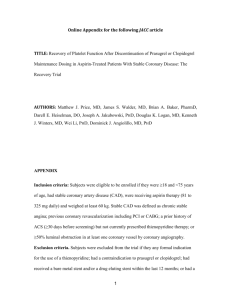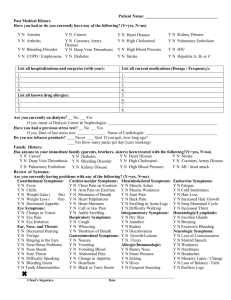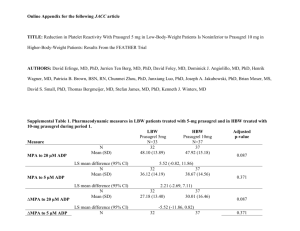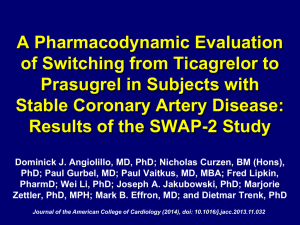Prasugrel hydrochloride
advertisement
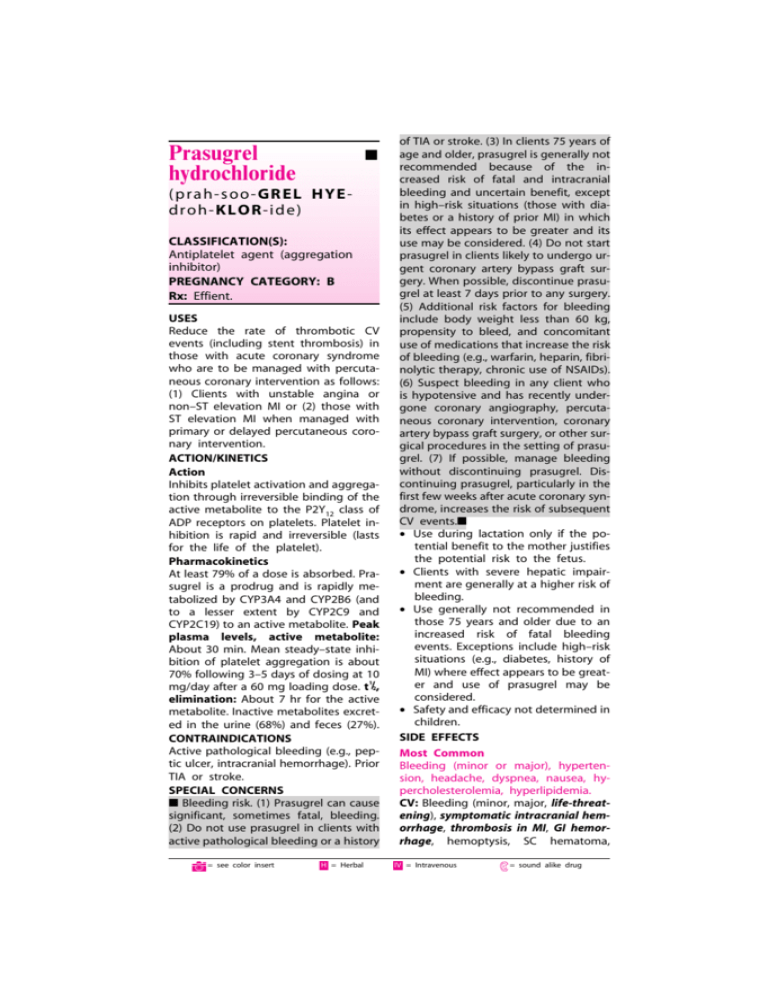
Prasugrel hydrochloride ■ (pr ah- s oo- GR EL HYE dr oh- KLO R- id e ) CLASSIFICATION(S): Antiplatelet agent (aggregation inhibitor) PREGNANCY CATEGORY: B Rx: Effient. USES Reduce the rate of thrombotic CV events (including stent thrombosis) in those with acute coronary syndrome who are to be managed with percutaneous coronary intervention as follows: (1) Clients with unstable angina or non–ST elevation MI or (2) those with ST elevation MI when managed with primary or delayed percutaneous coronary intervention. ACTION/KINETICS Action Inhibits platelet activation and aggregation through irreversible binding of the active metabolite to the P2Y12 class of ADP receptors on platelets. Platelet inhibition is rapid and irreversible (lasts for the life of the platelet). Pharmacokinetics At least 79% of a dose is absorbed. Prasugrel is a prodrug and is rapidly metabolized by CYP3A4 and CYP2B6 (and to a lesser extent by CYP2C9 and CYP2C19) to an active metabolite. Peak plasma levels, active metabolite: About 30 min. Mean steady–state inhibition of platelet aggregation is about 70% following 3–5 days of dosing at 10 1 mg/day after a 60 mg loading dose. t /2, elimination: About 7 hr for the active metabolite. Inactive metabolites excreted in the urine (68%) and feces (27%). CONTRAINDICATIONS Active pathological bleeding (e.g., peptic ulcer, intracranial hemorrhage). Prior TIA or stroke. SPECIAL CONCERNS ■ Bleeding risk. (1) Prasugrel can cause significant, sometimes fatal, bleeding. (2) Do not use prasugrel in clients with active pathological bleeding or a history C = see color insert H = Herbal of TIA or stroke. (3) In clients 75 years of age and older, prasugrel is generally not recommended because of the increased risk of fatal and intracranial bleeding and uncertain benefit, except in high–risk situations (those with diabetes or a history of prior MI) in which its effect appears to be greater and its use may be considered. (4) Do not start prasugrel in clients likely to undergo urgent coronary artery bypass graft surgery. When possible, discontinue prasugrel at least 7 days prior to any surgery. (5) Additional risk factors for bleeding include body weight less than 60 kg, propensity to bleed, and concomitant use of medications that increase the risk of bleeding (e.g., warfarin, heparin, fibrinolytic therapy, chronic use of NSAIDs). (6) Suspect bleeding in any client who is hypotensive and has recently undergone coronary angiography, percutaneous coronary intervention, coronary artery bypass graft surgery, or other surgical procedures in the setting of prasugrel. (7) If possible, manage bleeding without discontinuing prasugrel. Discontinuing prasugrel, particularly in the first few weeks after acute coronary syndrome, increases the risk of subsequent CV events.■ • Use during lactation only if the potential benefit to the mother justifies the potential risk to the fetus. • Clients with severe hepatic impairment are generally at a higher risk of bleeding. • Use generally not recommended in those 75 years and older due to an increased risk of fatal bleeding events. Exceptions include high–risk situations (e.g., diabetes, history of MI) where effect appears to be greater and use of prasugrel may be considered. • Safety and efficacy not determined in children. SIDE EFFECTS Most Common Bleeding (minor or major), hypertension, headache, dyspnea, nausea, hypercholesterolemia, hyperlipidemia. CV: Bleeding (minor, major, life-threatening), symptomatic intracranial hemorrhage, thrombosis in MI, GI hemorrhage, hemoptysis, SC hematoma, IV = Intravenous E = sound alike drug postprocedural hemorrhage, retroperitoneal hemorrhage, retinal hemorrhage, epistaxis. Hyper–/hypotension, atrial fibrillation, bradycardia. CNS: Headache, dizziness. GI: Nausea, diarrhea. Respiratory: Dyspnea, cough. Dermatologic: Rash. Hematologic: Leukopenia, severe thrombocytopenia, anemia, thrombotic thrombocytopenic purpura (including thrombocytopenia, microangiopathic hemolytic anemia). Body as a whole: Fatigue, peripheral edema, pyrexia, pain in extremity, allergic reactions, angioedema. Miscellaneous: Back pain, noncardiac chest pain, malignancies (e.g., colon, lung). NOTE: Factors that increase the risk of bleeding if using prasugrel include: Clients 75 years of age and older; coronary artery bypass graft or other surgical procedures; body weight less than 60 kg (use lower dose); propensity to bleed (e.g., recent trauma, recent surgery, recent or recurrent GI bleeding, active peptic ulcer disease, severe hepatic impairment); drugs that increase the risk of bleeding (e.g., PO anticoagulants, chronic use of NSAIDs, fibrinolytic drugs). LABORATORY TEST CONSIDERATIONS Hypercholesterolemia, hyperlipidemia. Abnormal liver function. OD OVERDOSE MANAGEMENT Symptoms: Platelet inhibition is rapid and irreversible and lasts for the life of the platelet; inhibition is unlikely to be increased in an overdose. Treatment: Platelet transfusions may restore clotting ability. Dialysis is not likely to remove the active metabolite. DRUG INTERACTIONS NSAIDs (chronic use) / 앖 Risk of bleeding Warfarin / 앖 Risk of bleeding HOW SUPPLIED Tablets: 5 mg, 10 mg. DOSAGE • TABLETS Acute coronary syndrome. Adults weighing 60 kg or more, usual: 10 mg once a day; adults weighing less than 60 kg, usual: 5 mg once a day should be considered. Loading dose: 60 mg. NOTE: Prasugrel should be taken with aspirin, 75–325 mg a day. Bold Italic = life threatening side effect NURSING CONSIDERATIONS ADMINISTRATION/STORAGE 1. May be given with or without food. Do not break the tablet. 2. The optimal duration of therapy is unknown. 3. Discontinue prasugrel for active bleeding, elective surgery, stroke, or TIA. 4. In clients managed with percutaneous coronary intervention and stent placement, premature discontinuation of prasugrel results in an increased risk of stent thrombosis, MI, and death. If prasugrel must be temporarily discontinued due to a side effect, restart therapy as soon as possible. 5. Store from 15–30°C (59–86°F). ASSESSMENT 1. Note reasons for therapy: MI or unstable angina managed by percutaneous coronary intervention (PCI). Administered with aspirin to reduce risk of MI/damage related to clots. 2. Avoid with any history of stroke or TIA, active bleeding, severe hepatic impairment, or potential for high risk of bleeding that could outweigh benefits. Also if >75 y.o., weight <60 kg, significant renal impairment, or if undergoing CABG, avoid therapy. 3. Drug inhibits platelet aggregation for the lifetime of the platelet (7-10 days). 4. Monitor BP, HR, EKG, CBC, renal and LFTs. 5. Drug is similar to plavix and seems to work better but has a much higher bleeding risk. CLIENT/FAMILY TEACHING 1. Take once daily with aspirin; do not break tabs. May take with food if GI upset. Drug helps prevent platelets from sticking together and forming a clot that can block an artery or a stent. 2. It takes longer than usual to stop bleeding and may bruise much easier. 3. Stop drug 7 days before any planned surgery or dental procedures. 4. Report any fever, weakness, extreme paleness or purple skin patches, yellowing of the skin or eyes, or neurologic changes. 5. Avoid alcohol and OTC agents, including NSAIDs without approval. ■ = black box warning W = Available in Canada 6. Keep all F/U to assess response, labs, and adverse SE. C = see color insert H = Herbal OUTCOMES/EVALUATE 앗 Thrombotic events with acute coronary syndrome (ACS) IV = Intravenous E = sound alike drug

